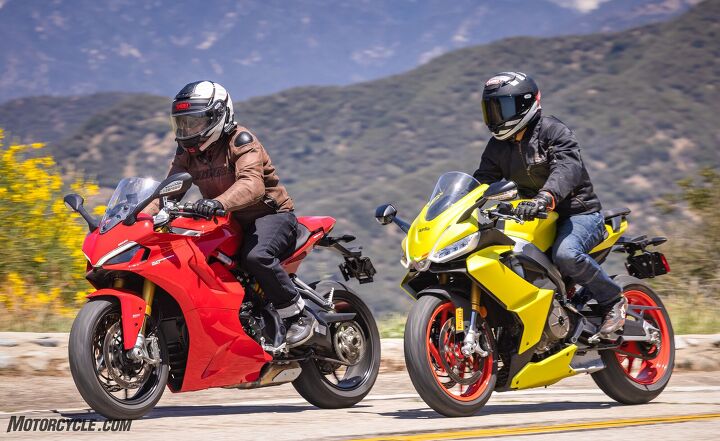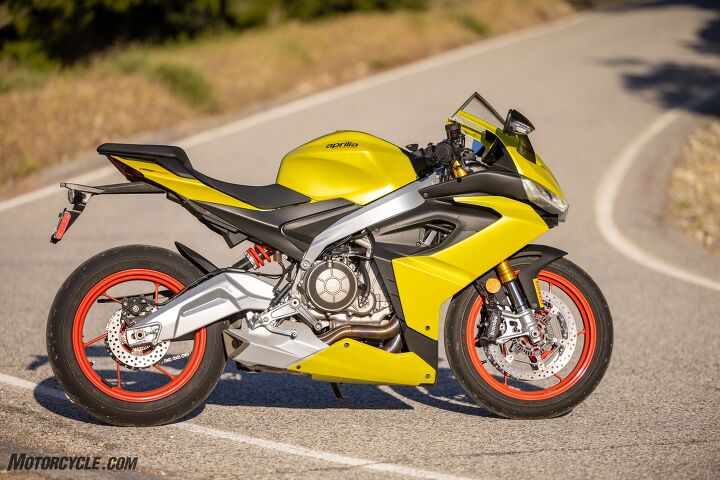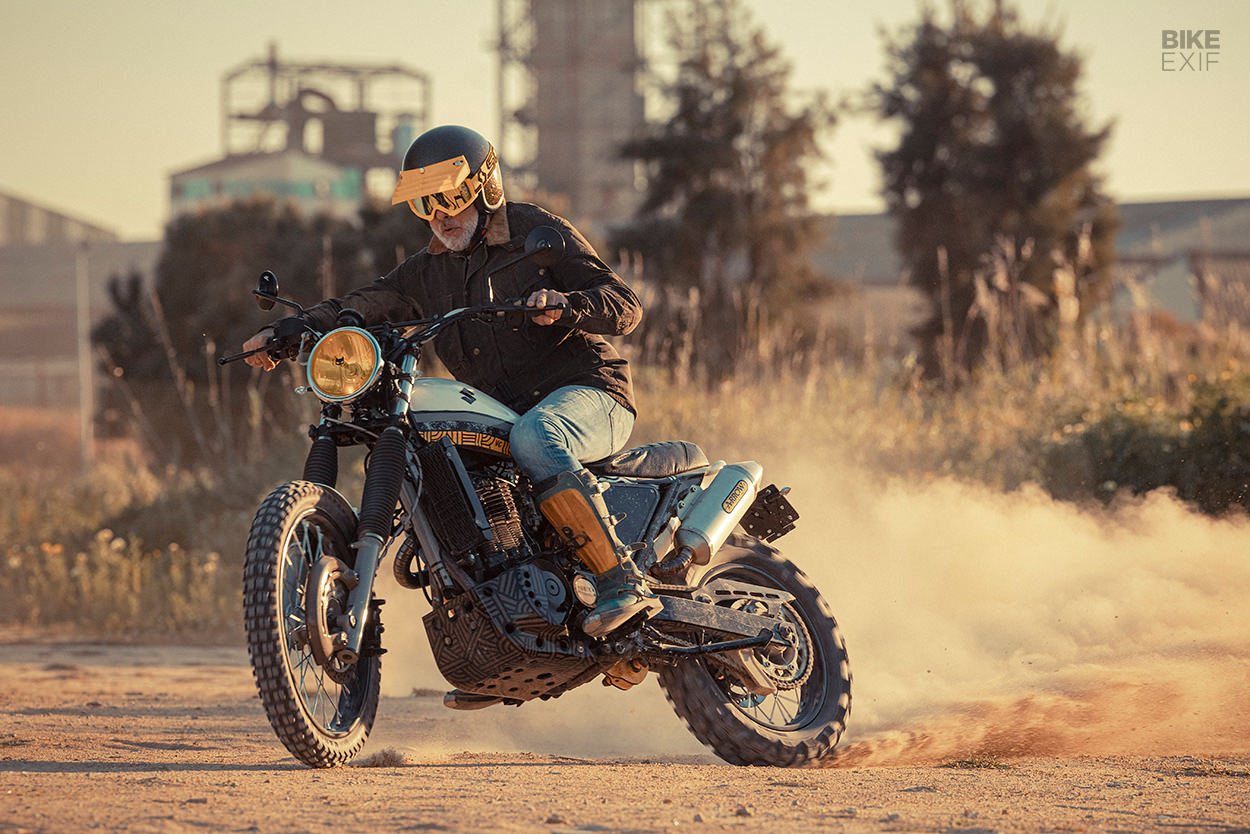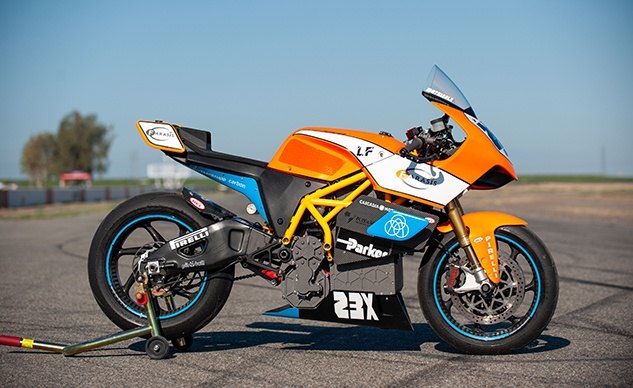There’s a certain romance in having a sporty motorcycle comfortable enough to ride the long way to a racetrack, participate in a trackday, then bee-line back home on after (or continue taking the long way, if you’re hardy). In reality, true sportbikes are terrible streetbikes – and even worse touring bikes. Conversely, a sport-touring bike is great at taking the long way to the track – and some are even respectable on said track – but ultimately leave something to be desired when the pace wicks up.
Splitting those differences are the motorcycles we have here: the 2021 Aprilia RS660 and Ducati Supersport 950 S. Sporty in nature and design but with a nod towards creature comforts, both Aprilia and Ducati are rethinking sportbikes for the more sensible among us. Outward appearances would tell you both bikes are in for a good time carving corners, but when you peel back the curtains (or fairings in this case), what lies underneath is what happens when people who don’t have professional racing contracts realize piloting 200-plus horsepower superbikes is downright scary and exhausting.
The point is, we tend to come back to a zone we call The Sweet Spot – roughly 100 horsepower, raised bars, less committed pegs, and a cushy seat. As the saying goes, though, the devil’s in the details, and here we have a look at how two storied cross-town rivals are approaching The Sweet Spot.
So, let’s take a quick moment to break down each motorcycle and where this test is headed.
The Break Down
Starting with the Aprilia RS660, it’s been a hotly anticipated model since it was announced. After riding it both on the street and at the track, I can attest that it is every bit a fun motorcycle belonging in The Sweet Spot. This was Aprilia’s intent, too – to create a sportbike that was actually rideable and not intimidating.
Based on the new, modular, 660 platform, the RS660 is the first in a line of models that will share this basic architecture, with the Tuono 660 also available and a more adventure-focused version called the Touareg 660 on the way (there are likely more models we don’t even know about yet also in the pipeline).
What we have with the RS660 is a fully-faired machine with rider comfort taking center stage ahead of outright performance. To that end, the “wings” integrated into the RS’s design aren’t meant for downforce, but rather to channel the engine’s heat away from the rider. Raised clip-ons are just high enough to be (relatively) comfortable on the street. But the biggest surprise is its seat. While not outwardly comfortable, sitting on it through an entire tank of gas is really not that bad – it’s incredibly well padded. Then, of course, we have the very feature no touring bike can be without: cruise control.

The magic cruise control switch (the toggle on top). It also doubles as the on-the-fly traction control setting switch. Photo: Kevin Wing
Power comes from a 660cc parallel Twin that’s essentially the front half of an RSV4 engine. Purists and nitpickers will say this is wholly inaccurate, but that’s why we used the word “essentially.” Nonetheless, it’s a cool engine with a 270-degree firing order giving it an even cooler sound. Rated at 100 horses at the crank, running it on the MotoGP Werks dyno shows 88 of those horses actually make it to the rear wheel, which sounds about right once you account for parasitic losses. Torque is right around 45 lb-ft, which is also on par with others in this displacement range. With a wet weight of 398 lbs on the MO scales, that comes out to one horsepower for every 4.5 pounds. A very respectable combo.
Over in the Ducati camp, the Supersport got some changes for 2021 to keep up with Euro 5 regs. Key among them is a six-axis IMU which, granted, doesn’t do anything to bring the bike up to snuff with Euro 5, but is important because it makes the traction and wheelie controls more sophisticated. Visually, the styling was brought more in line with the Panigale V4, too. Interestingly, while it’s common for bikes like the Supersport to be styled after a company flagship like the Panigale V4, Aprilia has turned the tables and restyled the new RSV4 after the RS660. Nonetheless, fancy electronics and styling aside, you’ll find a lot of similarities between the Ducati and Aprilia.
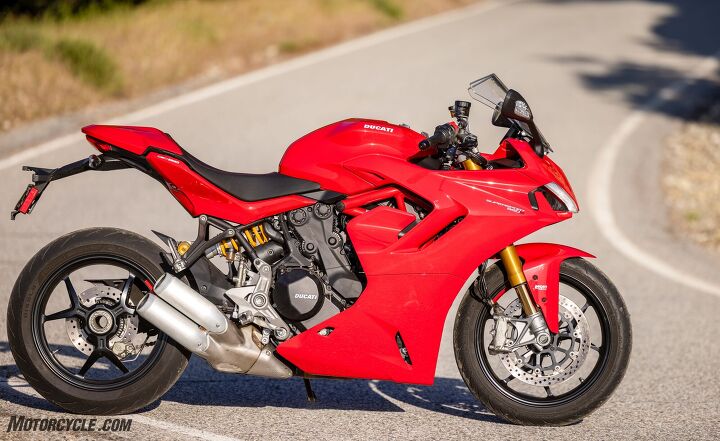
Panigale-inspired styling changes highlight the visual difference between old and new Supersports, but inside you’ll also find a six-axis IMU.
From the cockpit, the Supersport has a similar feel to the Aprilia. The 31.9-inch seat height is a tiny bit shorter than the 32.3-inch seat on the RS660, and its narrowness helps the rider plant a foot on the ground easily. Likewise, the bars feel higher than the Aprilia, giving an overall feeling of comfort over sport, especially in comparison to the RS660. A full-color TFT display greets both riders, and while their menus take a little fumbling to navigate, once you learn the button presses on both, things start to make sense.
At the heart of the Supersport is the 937cc Testastretta 11º V-Twin carried over from the previous Supersport (which also powers the new Monster). Emitting that familiar V-Twin rumble, it’s a thoroughly modern engine with that 11º valve overlap giving it excellent torque characteristics. Ducati claims about 110 hp at the crank, which sounds about right, as running it on the MotoGP Werks dyno revealed 102 horses (and change) getting to the ground. Torque was a healthy 65 lb-ft. On paper, the power discrepancy seems huge, but the Ducati also tips the scales at 469 lbs with a full tank of gas. Doing the math, and rounding up a tenth of a pound, this means the Supersport is using one horse for every 4.6 pounds. So, we’ve got a close matchup after all.

Underneath the plastic covers lies the 937cc Testastretta 11º V-Twin you’ll also find in the Hypermotard and the new Monster. It’s a fun and little thing, with just enough pep for the everyday rider.
Despite our request otherwise, Ducati sent us the more up-spec Supersport 950 S model. The main difference being the Öhlins fork and shock compared to the standard model’s Marzocchi fork and Sachs shock. Of course, with the better suspension comes a bigger price tag – $15,795 as-tested ($13,495 for the base model). Compare that with the Aprilia’s $11,499 as-tested price, itself incurring a $200 premium because of the Acid Gold color we have, and the delta is pretty big.
Going Riding
Here’s what we’re doing with these things. This isn’t really a head-to-head comparison test in the truest sense. Both bikes are billed as ones you wouldn’t mind being on for a few tanks of gas, while at the same time, being true to their respective Italian sporting roots, are machines you can also have a ton of fun with at the track. So, Burnsie and I did exactly that. We explore the sporty side of the sport-touring spectrum with two motorcycles that exercise different means to the same goal.

It’s not surprising to see the Ducati makes more power and torque everywhere compared to the smaller Aprilia. What caught us by surprise is the flat spot we felt in the RS660’s midrange isn’t apparent on the dyno. The spike at around 7600 rpm, while noticeable on the dyno chart, wasn’t so apparent from the saddle. John writes, “the acceleration gap isn’t as big as you’d suspect between 660 and 937 cc. Seems like the RS would destroy anything its own size.”
This is apparent the moment you sit on both bikes. As mentioned before, the RS660 feels tall and compact compared to the low, long Ducati. Ridden on its own, the Aprilia feels every bit the comfortable sporty bike it’s claimed to be. Even the boring slogs down the freeway, which is usually the worst place to ride a sportbike as the uncompromising position just eats away at you, is really not so bad on the RS660. Wind protection is decent, and once the slight buzz in the bars starts getting annoying, a simple flick of the cruise control will give you a chance to shake off the hands a little.
Our particular test bike was a pre-production unit – and actually the same bike I rode during the First Ride review – which might explain why the toggle switch to incrementally increase or decrease the cruise control speed stopped working. It worked when I first rode it all those many weeks (and miles) ago, so we’ll chalk this one up to being an anomaly.

It may not look it, but the Aprilia is surprisingly comfy with its raised bars and well-padded seat.
But when it comes to comfort, the Supersport is where it’s at. We already mentioned the comfortable, relaxed seating position, but the wind protection is also better thanks to the adjustable windscreen. As a street bike, the Supersport’s bigger engine lets the rider be lazy with their shifts, which you really don’t need to be since it has a quickshifter in both directions (as does the Aprilia).
JB even rode the Ducati from San Francisco to SoCal, before turning around and going to Buttonwillow to join me for a romp with our friends at Trackdaz (someone had to bring all the trackday extras, so I drove). Then he hopped on the RS660 and rode it back home. John being the kind of guy to tell you what’s on his mind, after his successful journey, he really didn’t mind being on either bike for either leg of the trip. Oddly enough, he really liked the Ducati – despite its lack of cruise control! (Reader, if you didn’t know, John Burns has spent the last, oh, decade, championing cruise control on every motorcycle. It’s often the deciding factor for him when wrapping up a motorcycle review. The fact the Ducati Supersport resonates so much with him, despite its lack of cruise control, is a big deal.)

But when it comes to comfort, the Supersport is where it’s at between these two. Having cruise control would have been the cherry on top.
Personally, I dig the Supersport on the street, too, for all the reasons already mentioned. However, the lack of cruise control really does bother me in this case. Thankfully, the aftermarket can easily solve that problem (granted, I’m talking about a simple device like a throttle lock, not real cruise control). What it might have a tougher time solving is the Ducati’s trademark rear cylinder exhaust heat wafting its way up to the rider. At anything short of highway speeds, the heat radiating from the engine starts to get annoying. Not Panigale-levels of hot or uncomfortable, mind you, but definitely noticeable. It would border on uncomfortable in the summer.
Twisty Stuff
The plot changes once the boring roads turn into good ones. It’s here the Aprilia’s playful nature comes through, and the power difference isn’t as important. The main attribute in the RS660’s favor? A substantially shorter wheelbase. Measuring 54.4 inches, the Aprila is nearly four inches shorter than the Ducati’s 58.3-inch wheelbase. Nevermind the fact the RS660’s 24.3º rake and 4.1 inches of trail are slightly lazier than the Supersport’s 24º rake and 3.6-inch trail, that difference in wheelbase translates into a swift and agile canyon carver the Ducati simply can’t match. Scribbling in his notes, Burns comments, “[the RS660] is obviously quicker-reacting when it’s time to change directions, and with no loss of stability compared to the Duc in the fast bends.”

“You can feel the reduced weight in every transition,” says John. It’s true, a 70-pound weight difference in the Aprilia’s favor is clearly noticeable.
It’s not like the Supersport is a pig, but side-to-side transitions are noticeably slower compared to the RS660. As with most things in life, the Supersport has to compromise somewhere: a 90º V-Twin is a long engine, and when you place the lower cylinder nearly horizontal, it pushes the rest of the bike back to accommodate. This is partially why the compactness of parallel-Twins is so popular these days. To Ducati’s credit, this length results in supreme stability once over on its side.
Further differences make themselves known in how each bike prefers to get through a set of curves. The Aprilia is perfectly happy being tossed from side to side, especially if its rider is deft with the quickshifter to make sure the RS stays relatively high in the revs. It’s a nice place to be, too, as the intake snarl and exhaust growl is auditory bliss. Get it wrong, however, and you’ll get caught in the RS660’s giant flat spot in the midrange – a similar phenomenon Ryan Adams first experienced aboard the Tuono 660.
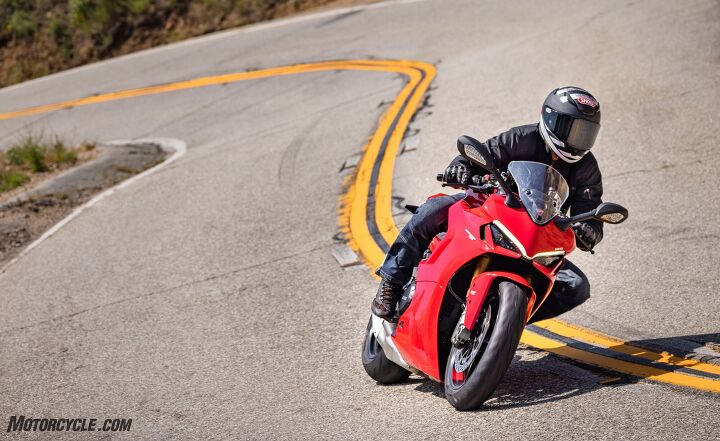
More from Burnsie, this time about the Supersport: “Nice and stable, long and low like all the classic freight-train Ducs of old. Makes it fun to roar through the fast kinks… but then also makes it less quick in side-to-side transitions.”
For its part, the Supersport is much more deserving of the term “gentleman’s sportbike.” Brute force that’s rewarded on the Aprilia isn’t a benefit on the Ducati, as smoothness wins the day here. Part of this comes down to the longer wheelbase mentioned earlier. Part of it also comes down to seating position. You’re sitting more “inside” the Ducati instead of atop like on the Aprilia, and with this relaxed seating position it encourages the rider not to force anything.
If smoothness and laziness appeals to you, then the engine will be a real highlight. As the saying goes, there really is no replacement for displacement, and the big torque advantage the Ducati enjoys allows the rider to be less concerned about the gear they’re in. Once they’re ready, simply twisting the throttle will scoot them along – it doesn’t matter much if you’re a gear high.
Track

“[The Aprilia] kinda feels like a young rambunctious puppy jumping up and down and nipping at the old Ducati’s flanks and wanting to play,” says John.
If both bikes come alive when the roads turn twisty, then the racetrack should be very telling indeed – and it is – as all of the attributes above for both bikes get ramped up another notch.
It shouldn’t be surprising, then, to discover the Aprilia’s playful nature on windy roads shines even brighter on a racetrack. With its short wheelbase and only 398lbs to throw around, the RS660 is seemingly toyish on track. It steers considerably faster without giving up much, if any, in terms of stability. The lull in the midrange is a non-issue with the high-rpm nature of the track and the smooth up/down quickshifter never misses a beat.

The RS660 is perfectly at home on the track, where its playful nature really comes out. “It’s more at home in the tighter parts of the track,” Burns says, “which are mostly the funner parts too.”
Though not as prestigious as the Öhlins bits on the Ducati, the Kayaba suspension fitted on the Aprilia worked well enough for us. Adding a little preload to the front and dialing a few of the clickers in the morning worked so well, in fact, that we didn’t touch a setting the rest of the day.
The Ducati, meanwhile, is clearly not a track bike in the same sense as the RS660. But that doesn’t mean it’s slow. The strength of its engine scoots it along nicely, but it doesn’t leap away from the Aprilia – a product, we suspect, of the 70 extra pounds the Supersport carries on its back.

Being a Ducati, the Supersport can handle track duty just fine. Just be careful with your right side ground clearance.
Yes, quick transitions are where the Ducati struggles in comparison to the Aprilia, but it still holds its own just fine. Feel and compliance from both ends and the overall chassis are superb thanks to the Öhlins suspension. As Burns notes, “that Öhlins stuff on the S is fantastic; it was plush on the 600 road miles I put on the thing, then when [Ducati technician] Dan the man dialled in the track settings, it was transformed into a solid track bike.”
Those track settings John refers to include adding preload to both ends to help bring the bike’s center up higher. This is further accomplished by lowering the forks inside the triple so the tops were flush, effectively raising the front end of the motorcycle even more. While bump compliance and feel from either end was never an issue, it quickly became apparent why the bike had to be raised for track use as soon as I tipped it over on its right side. The scraping sound initially had me thinking I was being lazy and scraping my toe on the pavement. However, with my toe lifted and the sound persisting, I realized it was the exhaust dragging on the ground!

Get a little too ambitious with your right handers on the Supersport and you’ll start to lose exhaust weight over time as it grinds away on the ground. Assuming, of course, it doesn’t spit you off first. Also, Ducati says rear wheel removal requires taking off the exhaust tips first. Isn’t a major selling point of single-sided swingarms the ease of wheel removal?
Hard parts are never things you want dragging on the ground during a trackday, and especially not the exhaust. Other than the potential safety aspect of the exhaust lifting the rear tire off the ground if lean angles get too excessive, who wants to destroy their components like that? Even though the majority of people will swap out their exhaust for something from the aftermarket, if the occasional track ride is something you look forward to with the Supersport, then a high-mount exhaust is a must.
Electronics: The Difference Maker
Okay, the exhaust scraping thing is a rather significant blemish for the Ducati, but it’s also unlikely true track demons are eyeballing the Supersport in the first place. Exhaust scraping aside, the beauty of both bikes is just how easy and fun they are to ride quickly. Track or street. Braking performance between the two is essentially a wash, as both wear Brembo radial-mount calipers and 320mm discs, though maybe somewhat surprisingly, if we had to give the nod it would go to the heavier Ducati for its slightly better initial bite.

The TFT screen on the RS660 is colorful and displays the relevant information. “Individual” mode seen at the top is one of five different ride modes.
If anything, this comparison has revealed there are aspects about both we really like, accompanied by quirks we really don’t. In the Aprilia’s case, its sporty nature is fun and exciting, while it’s marginally less comfortable. This isn’t so bad, though, because it has cruise control. Meanwhile, the Ducati is comfy, well suspended, and its engine is excellent, but it’s hot, a smidge lethargic compared to the RS, and doesn’t come with cruise control. This seems like a glaring omission considering the bike’s intended use.
There is, however, another area of clear separation between the Ducati and the Aprilia: the electronics. Yes, both bikes have ride modes, and yes, the Supersport’s 4.3-inch TFT screen is more visually appealing than the RS660’s, but where it counts is how the rider aids function. Specifically, we’re talking about traction control, and this is the area where Ducati’s might shines through. Both bikes are equipped with six-axis IMUs, but it takes manpower and resources to integrate the data from the IMU into a seamless traction control system the rider barely notices.
Both bikes were ridden on track (and street) with the stock Pirelli tires, and while outright grip doesn’t match a dedicated track tire, there’s still plenty there to comfortably hang with the fast group at a trackday. The unintended (but beneficial) consequence, however, was being able to experience how each bike’s traction control system works when the rear tires got greasy.
Lowering the TC setting to level 1 was extremely easy on the RS660, as the toggle on the left bar can be tapped up or down on the fly. However, even at this lowest setting, the Aprilia’s system dials back the power significantly – to the point it almost feels like the bike has run out of gas – and just when you look down at the dash to make sure everything’s okay, the power comes back to life and lurches you forward.

When you’re running from a mob of bikes, you tend to get greedy with the throttle. If/when the Aprilia’s traction control kicks in, the mob behind might be spooked by your acceleration – or lack thereof.
In contrast, the Ducati traction control, while noticeable, is much more seamless in its operation than the Aprilia. The rate at which power is dialed back is considerably more muted compared to the RS660, and conversely, the rate power comes back is considerably more progressive. The tradeoff (there’s always a tradeoff) is accessing the TC settings requires a series of button presses you simply can’t do on the fly.
Burns and I both agreed the Ducati’s TC is simply better, although John was more poetic about it, noting “you have to love the DTC, especially cresting those corners over rises at Buttonwillow when everything goes all light for a second. How did we live without it all those years? I’ll answer that: We crashed more.”

The Supersport also cuts back power when TC kicks in, but it shouldn’t be enough to startle the chasing pack.
Different Strokes For Different Folks
There you have it. Both the Ducati Supersport 950 S and Aprilia RS660 handle the task of sporty street riding and trackday duty competently, but in very different ways. And as we’ve found out, both bikes have attributes we like, accompanied by things we equally dislike.
We said at the onset that this wasn’t a true comparison test, per se, but as usual when it comes down to tests like these, the reader always wants to know who the winner is anyway. The cop-out answer is… it depends. In this case, it really is true. If you value comfort over sport and only envision a couple trackdays a year, go Ducati. In fact, despite dedicating the last decade of his life championing cruise control, even our own John Burns picked the cruise control-less Ducati as the bike he’d have if forced to pick one (he really picked neither) simply because he’s less of a track rider these days. There’s also a bit of nostalgia, too. Peep his notes: “I associate the term Ducati Supersport with the old air-cooled machines, but this one feels just like a really dialled 998 circa 2002, which makes sense since that was the first Testastretta, just like this bike has. And was one of my fave Ducs of all time.”

Proving once again how unpredictable ‘ol Burnsie can be, he ultimately picked the Ducati. Maybe cruise control doesn’t mean as much to him after all?
I’m on the opposite end of the spectrum compared to John these days. The track has lately become my second home, and middleweight twin-cylinder sporty bikes have always been one of my favorite categories. Street riding is a means to an end in my case, so having cruise control to get me through it is a blessing. With that in mind, it’s clear why the Aprilia is my choice. Mix in its lower price tag and the emergence of what will soon be a booming aftermarket, and the RS660 makes sense for folks like me.
See? It really does depend on your flavor.
| 2021 Aprilia RS660 | |
+ Highs
|
– Sighs
|
| 2021 Ducati Supersport 950 S | |
+ Highs
|
– Sighs
|
| Specifications | Aprilia RS660 | Ducati Supersport 950 S |
|---|---|---|
| MSRP | $11,299 – $11,499 | $15,795 (base is $13,495) |
| Engine Type | liquid-cooled parallel-twin, DOHC, four valves per cylinder | Testastretta 11°, L-Twin cylinder, 4 valve per cylinder, Desmodromic, liquid cooled |
| Displacement | 659cc | 937 cc |
| Bore x Stroke | 81mm x 63.9mm | 94mm x 67.5mm |
| Compression Ratio | 13.5:1 | 12.6:1 |
| Maximum Power, rear wheel dyno | 88.6 hp @ 10,800 rpm | 102.4 hp @ 9,200 rpm |
| Maximum Torque, rear-wheel dyno | 44.8 ft-lb. @ 9,100 rpm | 65.2 ft-lb @ 7,700 rpm |
| Fuel system | EFI, Ride-by-Wire | Electronic fuel injection system, 53 mm throttle bodies with full Ride-by-Wire |
| Final drive | Chain | Chain |
| Clutch | Wet, assist & slip, multi-plate clutch | Slipper and self-servo wet multiplate clutch with hydraulic control. Self bleeding master cylinder |
| Transmission | 6-speed with Aprilia Quick Shift up-and-down system | 6 speed with Ducati Quick Shift (DQS) up/down EVO |
| Frame | Die-cast aluminum frame, two lateral beams | Tubular steel Trellis frame attached to the cylinder heads |
| Swingarm | Aluminum swingarm with asymmetrical trusses. | Single-sided, aluminum |
| Front Tire | 120/70-17, Pirelli Diablo Rosso III | 120/70 ZR17, Pirelli Diablo Rosso III |
| Rear Tire | 180/55-17, Pirelli Diablo Rosso III | 180/55 ZR17, Pirelli Diablo Rosso III |
| Front Suspension | Kayaba 41 mm upside-down fork, adjustable for rebound, and spring preload. Wheel travel 4.7 inches (120mm) | Fully adjustable Æ 48 mm usd Öhlins fork with TiN treatment |
| Rear Suspension | Monoshock with adjustable rebound and spring preload. Wheel travel: 5.1 inches (130mm) | Progressive linkage with fully adjustable Öhlins monoshock. Aluminum single-sided swingarm |
| Front Brake | Dual radial-mounted Brembo calipers with four 32mm pistons. 320mm discs. Radial master cylinder and steel braided brake lines with Cornering ABS | 2 x 320 mm semi-floating discs, radially mounted Monobloc Brembo M4-32 callipers, 4-piston, radial pump with Bosch Cornering ABS. Self bleeding master cylinder |
| Rear Brake | Single Brembo caliper with two 34mm pistons. 220mm disc with Cornering ABS | 245 mm disc, 2-piston caliper, BoschCornering ABS |
| Rake | 24.1° | 24.0° |
| Trail | 4.1 inches | 3.6 inches |
| Wheelbase | 53.9 inches | 58.3 inches |
| Seat Height | 32.3 inches | 31.9 inches |
| Fuel Capacity | 3.96 gallons | 4.2 gallons |
| Weight | 398 pounds (wet, measured) | 469 pounds (wet, measured) |
We are committed to finding, researching, and recommending the best products. We earn commissions from purchases you make using the retail links in our product reviews. Learn more about how this works.
Become a Motorcycle.com insider. Get the latest motorcycle news first by subscribing to our newsletter here.
Source link


